Organizational Behaviour Analysis: Tesco, Unit 12, HND Business
VerifiedAdded on 2023/01/12
|12
|3810
|30
Report
AI Summary
This report provides a comprehensive analysis of organizational behaviour, focusing on the case study of Tesco. It begins with an introduction to the influence of culture, power, and politics on organizational behaviour, examining how these factors impact employee performance and overall business objectives. The report then delves into motivation theories, including content and process theories, such as Maslow's hierarchy of needs, Herzberg's two-factor theory, equity theory, and expectancy theory, providing insights into how to enhance employee motivation and productivity. Furthermore, the report explores effective team theories, discussing the characteristics of effective teams and team development models. Finally, the report concludes with a discussion on the concepts and philosophies of organizational behaviour, providing a holistic view of how these elements contribute to Tesco's operational success. The report draws upon various theories and models to offer practical recommendations for improving employee engagement, teamwork, and overall organizational effectiveness within Tesco's context.
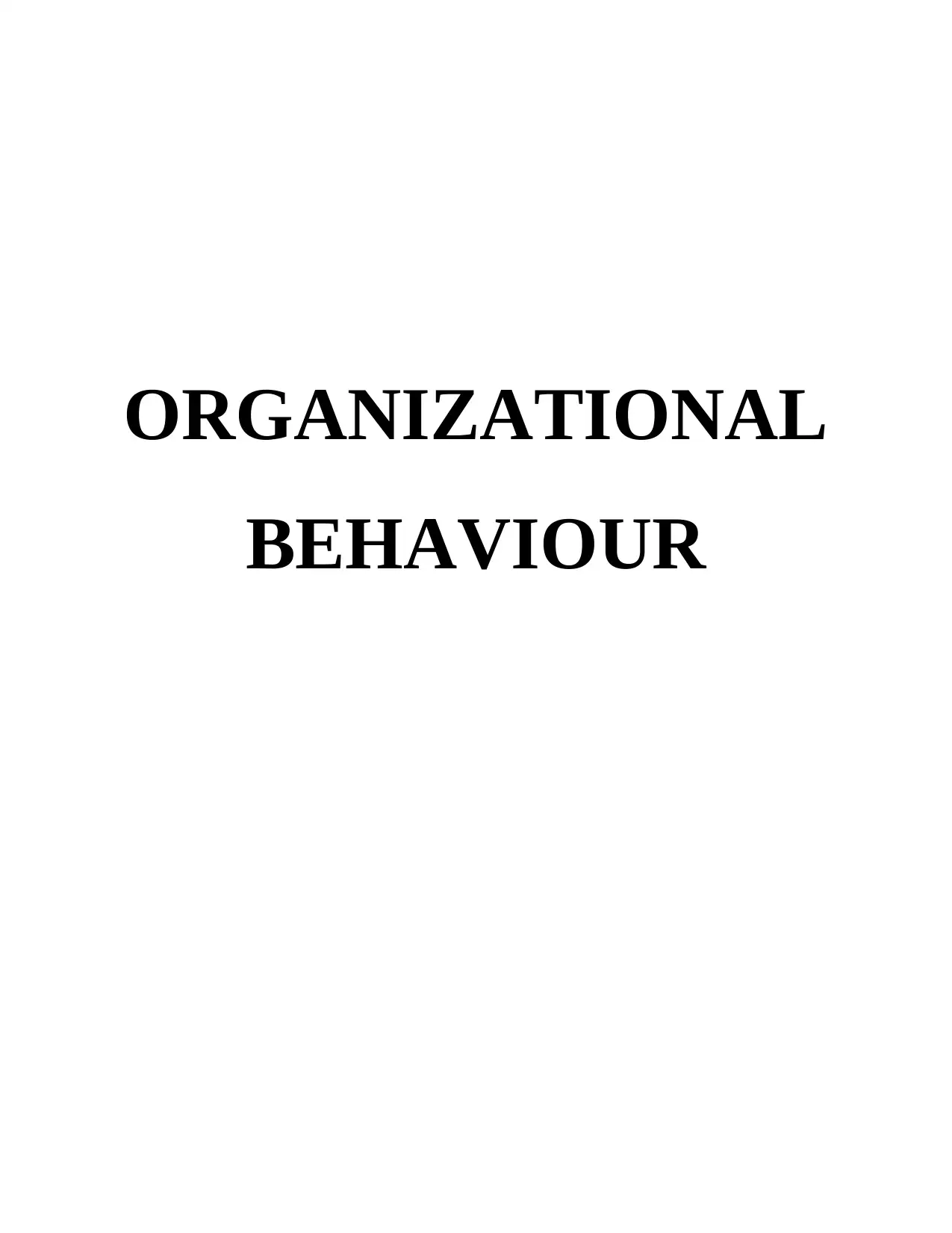
ORGANIZATIONAL
BEHAVIOUR
BEHAVIOUR
Paraphrase This Document
Need a fresh take? Get an instant paraphrase of this document with our AI Paraphraser
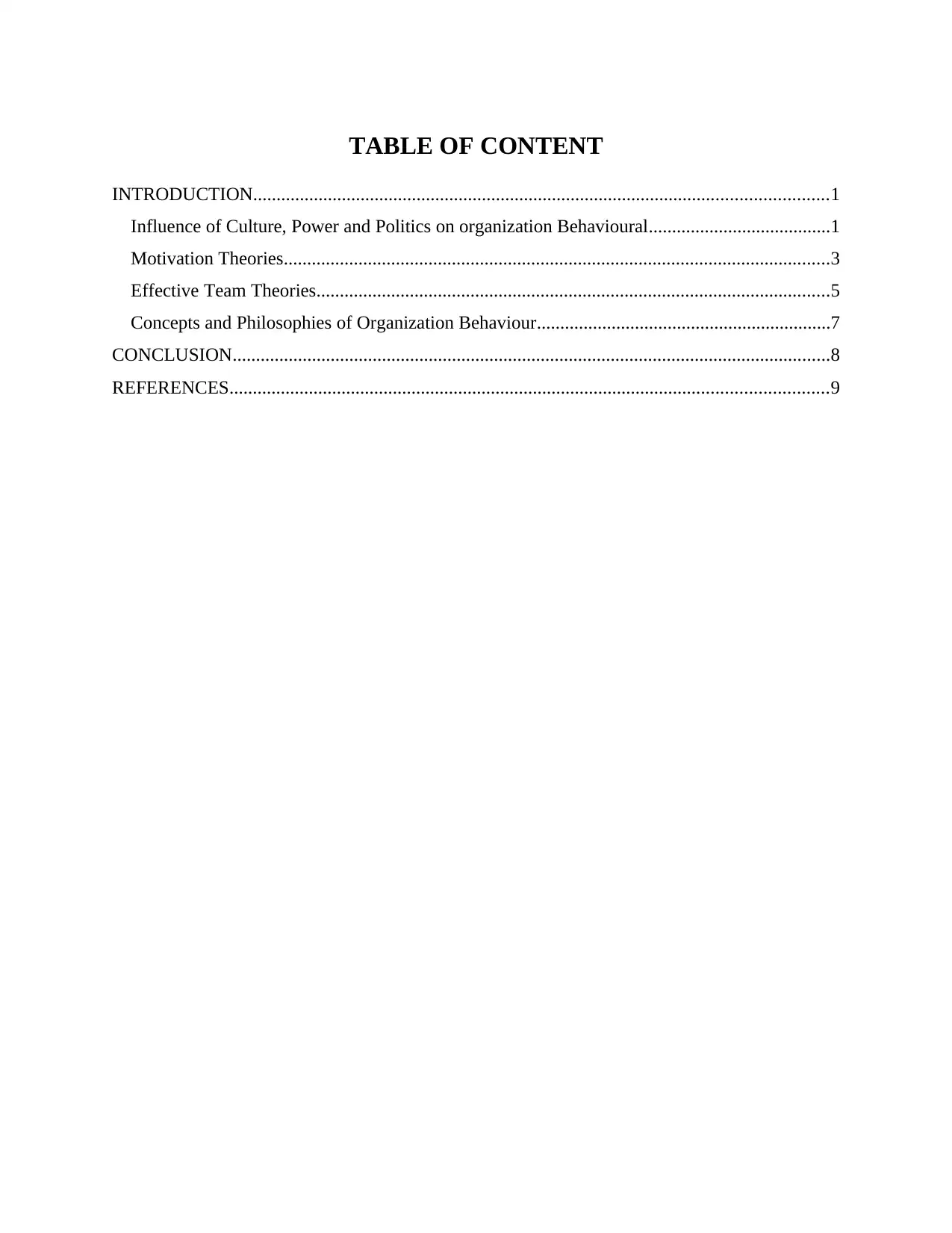
TABLE OF CONTENT
INTRODUCTION...........................................................................................................................1
Influence of Culture, Power and Politics on organization Behavioural.......................................1
Motivation Theories.....................................................................................................................3
Effective Team Theories..............................................................................................................5
Concepts and Philosophies of Organization Behaviour...............................................................7
CONCLUSION................................................................................................................................8
REFERENCES................................................................................................................................9
INTRODUCTION...........................................................................................................................1
Influence of Culture, Power and Politics on organization Behavioural.......................................1
Motivation Theories.....................................................................................................................3
Effective Team Theories..............................................................................................................5
Concepts and Philosophies of Organization Behaviour...............................................................7
CONCLUSION................................................................................................................................8
REFERENCES................................................................................................................................9
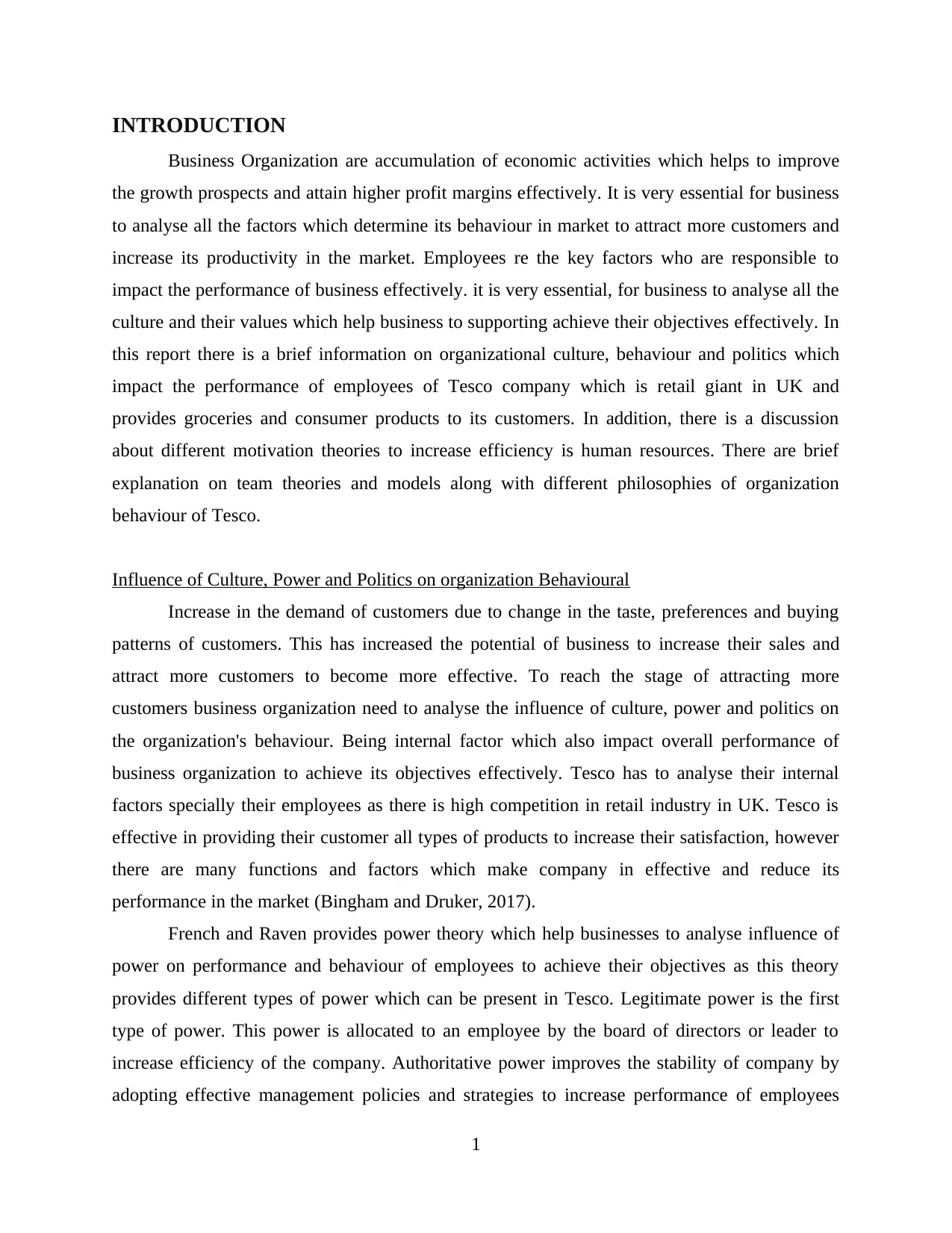
INTRODUCTION
Business Organization are accumulation of economic activities which helps to improve
the growth prospects and attain higher profit margins effectively. It is very essential for business
to analyse all the factors which determine its behaviour in market to attract more customers and
increase its productivity in the market. Employees re the key factors who are responsible to
impact the performance of business effectively. it is very essential, for business to analyse all the
culture and their values which help business to supporting achieve their objectives effectively. In
this report there is a brief information on organizational culture, behaviour and politics which
impact the performance of employees of Tesco company which is retail giant in UK and
provides groceries and consumer products to its customers. In addition, there is a discussion
about different motivation theories to increase efficiency is human resources. There are brief
explanation on team theories and models along with different philosophies of organization
behaviour of Tesco.
Influence of Culture, Power and Politics on organization Behavioural
Increase in the demand of customers due to change in the taste, preferences and buying
patterns of customers. This has increased the potential of business to increase their sales and
attract more customers to become more effective. To reach the stage of attracting more
customers business organization need to analyse the influence of culture, power and politics on
the organization's behaviour. Being internal factor which also impact overall performance of
business organization to achieve its objectives effectively. Tesco has to analyse their internal
factors specially their employees as there is high competition in retail industry in UK. Tesco is
effective in providing their customer all types of products to increase their satisfaction, however
there are many functions and factors which make company in effective and reduce its
performance in the market (Bingham and Druker, 2017).
French and Raven provides power theory which help businesses to analyse influence of
power on performance and behaviour of employees to achieve their objectives as this theory
provides different types of power which can be present in Tesco. Legitimate power is the first
type of power. This power is allocated to an employee by the board of directors or leader to
increase efficiency of the company. Authoritative power improves the stability of company by
adopting effective management policies and strategies to increase performance of employees
1
Business Organization are accumulation of economic activities which helps to improve
the growth prospects and attain higher profit margins effectively. It is very essential for business
to analyse all the factors which determine its behaviour in market to attract more customers and
increase its productivity in the market. Employees re the key factors who are responsible to
impact the performance of business effectively. it is very essential, for business to analyse all the
culture and their values which help business to supporting achieve their objectives effectively. In
this report there is a brief information on organizational culture, behaviour and politics which
impact the performance of employees of Tesco company which is retail giant in UK and
provides groceries and consumer products to its customers. In addition, there is a discussion
about different motivation theories to increase efficiency is human resources. There are brief
explanation on team theories and models along with different philosophies of organization
behaviour of Tesco.
Influence of Culture, Power and Politics on organization Behavioural
Increase in the demand of customers due to change in the taste, preferences and buying
patterns of customers. This has increased the potential of business to increase their sales and
attract more customers to become more effective. To reach the stage of attracting more
customers business organization need to analyse the influence of culture, power and politics on
the organization's behaviour. Being internal factor which also impact overall performance of
business organization to achieve its objectives effectively. Tesco has to analyse their internal
factors specially their employees as there is high competition in retail industry in UK. Tesco is
effective in providing their customer all types of products to increase their satisfaction, however
there are many functions and factors which make company in effective and reduce its
performance in the market (Bingham and Druker, 2017).
French and Raven provides power theory which help businesses to analyse influence of
power on performance and behaviour of employees to achieve their objectives as this theory
provides different types of power which can be present in Tesco. Legitimate power is the first
type of power. This power is allocated to an employee by the board of directors or leader to
increase efficiency of the company. Authoritative power improves the stability of company by
adopting effective management policies and strategies to increase performance of employees
1
⊘ This is a preview!⊘
Do you want full access?
Subscribe today to unlock all pages.

Trusted by 1+ million students worldwide
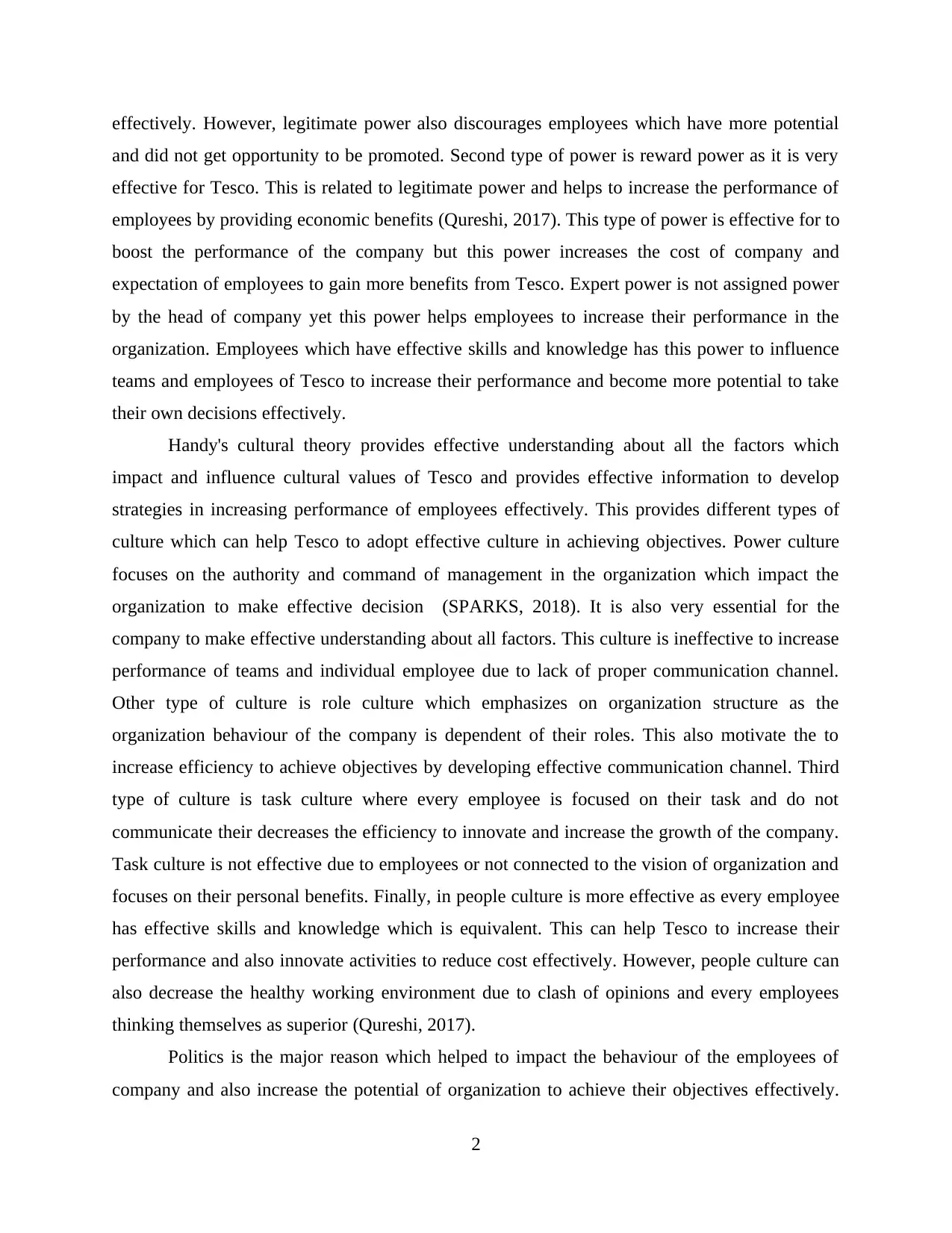
effectively. However, legitimate power also discourages employees which have more potential
and did not get opportunity to be promoted. Second type of power is reward power as it is very
effective for Tesco. This is related to legitimate power and helps to increase the performance of
employees by providing economic benefits (Qureshi, 2017). This type of power is effective for to
boost the performance of the company but this power increases the cost of company and
expectation of employees to gain more benefits from Tesco. Expert power is not assigned power
by the head of company yet this power helps employees to increase their performance in the
organization. Employees which have effective skills and knowledge has this power to influence
teams and employees of Tesco to increase their performance and become more potential to take
their own decisions effectively.
Handy's cultural theory provides effective understanding about all the factors which
impact and influence cultural values of Tesco and provides effective information to develop
strategies in increasing performance of employees effectively. This provides different types of
culture which can help Tesco to adopt effective culture in achieving objectives. Power culture
focuses on the authority and command of management in the organization which impact the
organization to make effective decision (SPARKS, 2018). It is also very essential for the
company to make effective understanding about all factors. This culture is ineffective to increase
performance of teams and individual employee due to lack of proper communication channel.
Other type of culture is role culture which emphasizes on organization structure as the
organization behaviour of the company is dependent of their roles. This also motivate the to
increase efficiency to achieve objectives by developing effective communication channel. Third
type of culture is task culture where every employee is focused on their task and do not
communicate their decreases the efficiency to innovate and increase the growth of the company.
Task culture is not effective due to employees or not connected to the vision of organization and
focuses on their personal benefits. Finally, in people culture is more effective as every employee
has effective skills and knowledge which is equivalent. This can help Tesco to increase their
performance and also innovate activities to reduce cost effectively. However, people culture can
also decrease the healthy working environment due to clash of opinions and every employees
thinking themselves as superior (Qureshi, 2017).
Politics is the major reason which helped to impact the behaviour of the employees of
company and also increase the potential of organization to achieve their objectives effectively.
2
and did not get opportunity to be promoted. Second type of power is reward power as it is very
effective for Tesco. This is related to legitimate power and helps to increase the performance of
employees by providing economic benefits (Qureshi, 2017). This type of power is effective for to
boost the performance of the company but this power increases the cost of company and
expectation of employees to gain more benefits from Tesco. Expert power is not assigned power
by the head of company yet this power helps employees to increase their performance in the
organization. Employees which have effective skills and knowledge has this power to influence
teams and employees of Tesco to increase their performance and become more potential to take
their own decisions effectively.
Handy's cultural theory provides effective understanding about all the factors which
impact and influence cultural values of Tesco and provides effective information to develop
strategies in increasing performance of employees effectively. This provides different types of
culture which can help Tesco to adopt effective culture in achieving objectives. Power culture
focuses on the authority and command of management in the organization which impact the
organization to make effective decision (SPARKS, 2018). It is also very essential for the
company to make effective understanding about all factors. This culture is ineffective to increase
performance of teams and individual employee due to lack of proper communication channel.
Other type of culture is role culture which emphasizes on organization structure as the
organization behaviour of the company is dependent of their roles. This also motivate the to
increase efficiency to achieve objectives by developing effective communication channel. Third
type of culture is task culture where every employee is focused on their task and do not
communicate their decreases the efficiency to innovate and increase the growth of the company.
Task culture is not effective due to employees or not connected to the vision of organization and
focuses on their personal benefits. Finally, in people culture is more effective as every employee
has effective skills and knowledge which is equivalent. This can help Tesco to increase their
performance and also innovate activities to reduce cost effectively. However, people culture can
also decrease the healthy working environment due to clash of opinions and every employees
thinking themselves as superior (Qureshi, 2017).
Politics is the major reason which helped to impact the behaviour of the employees of
company and also increase the potential of organization to achieve their objectives effectively.
2
Paraphrase This Document
Need a fresh take? Get an instant paraphrase of this document with our AI Paraphraser
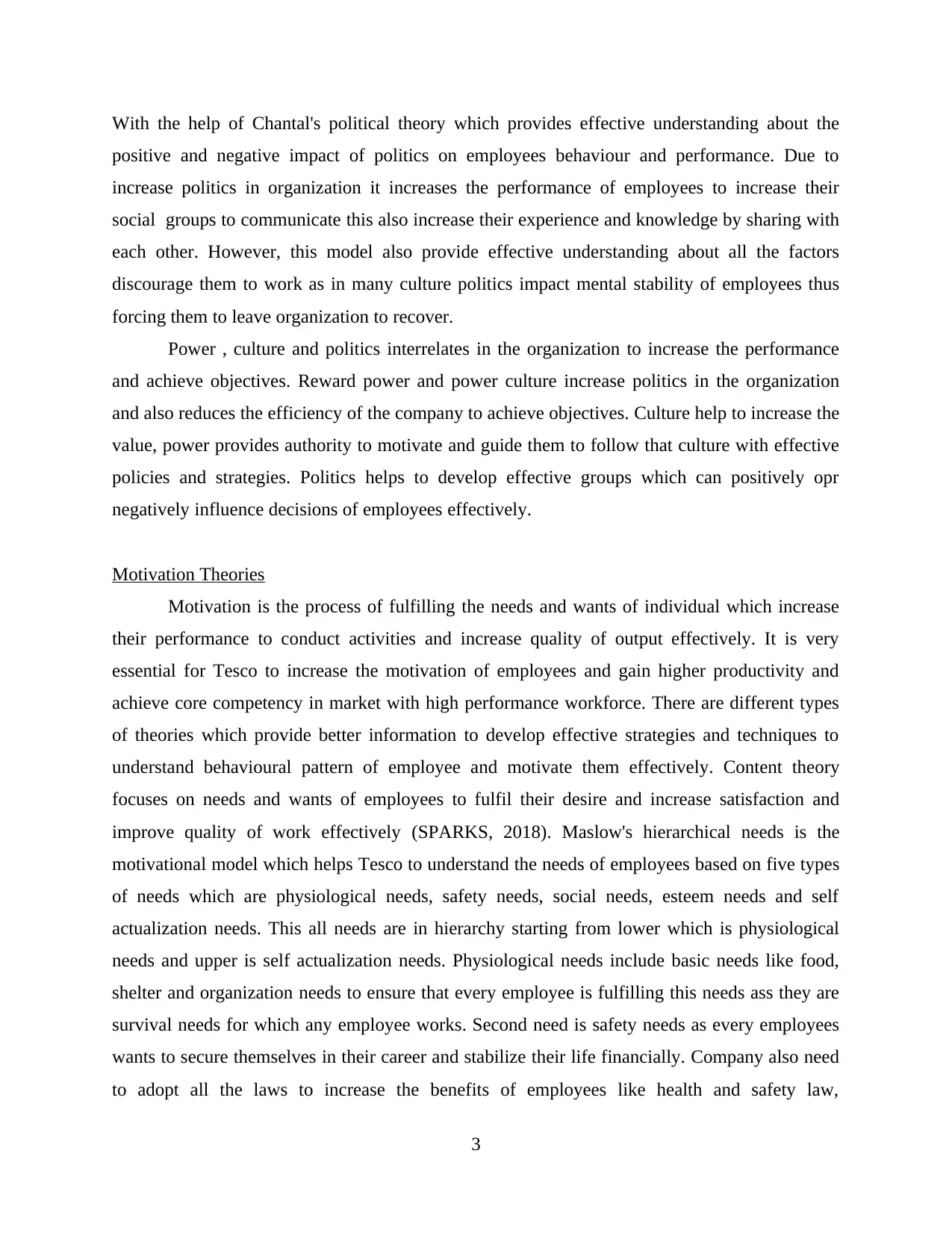
With the help of Chantal's political theory which provides effective understanding about the
positive and negative impact of politics on employees behaviour and performance. Due to
increase politics in organization it increases the performance of employees to increase their
social groups to communicate this also increase their experience and knowledge by sharing with
each other. However, this model also provide effective understanding about all the factors
discourage them to work as in many culture politics impact mental stability of employees thus
forcing them to leave organization to recover.
Power , culture and politics interrelates in the organization to increase the performance
and achieve objectives. Reward power and power culture increase politics in the organization
and also reduces the efficiency of the company to achieve objectives. Culture help to increase the
value, power provides authority to motivate and guide them to follow that culture with effective
policies and strategies. Politics helps to develop effective groups which can positively opr
negatively influence decisions of employees effectively.
Motivation Theories
Motivation is the process of fulfilling the needs and wants of individual which increase
their performance to conduct activities and increase quality of output effectively. It is very
essential for Tesco to increase the motivation of employees and gain higher productivity and
achieve core competency in market with high performance workforce. There are different types
of theories which provide better information to develop effective strategies and techniques to
understand behavioural pattern of employee and motivate them effectively. Content theory
focuses on needs and wants of employees to fulfil their desire and increase satisfaction and
improve quality of work effectively (SPARKS, 2018). Maslow's hierarchical needs is the
motivational model which helps Tesco to understand the needs of employees based on five types
of needs which are physiological needs, safety needs, social needs, esteem needs and self
actualization needs. This all needs are in hierarchy starting from lower which is physiological
needs and upper is self actualization needs. Physiological needs include basic needs like food,
shelter and organization needs to ensure that every employee is fulfilling this needs ass they are
survival needs for which any employee works. Second need is safety needs as every employees
wants to secure themselves in their career and stabilize their life financially. Company also need
to adopt all the laws to increase the benefits of employees like health and safety law,
3
positive and negative impact of politics on employees behaviour and performance. Due to
increase politics in organization it increases the performance of employees to increase their
social groups to communicate this also increase their experience and knowledge by sharing with
each other. However, this model also provide effective understanding about all the factors
discourage them to work as in many culture politics impact mental stability of employees thus
forcing them to leave organization to recover.
Power , culture and politics interrelates in the organization to increase the performance
and achieve objectives. Reward power and power culture increase politics in the organization
and also reduces the efficiency of the company to achieve objectives. Culture help to increase the
value, power provides authority to motivate and guide them to follow that culture with effective
policies and strategies. Politics helps to develop effective groups which can positively opr
negatively influence decisions of employees effectively.
Motivation Theories
Motivation is the process of fulfilling the needs and wants of individual which increase
their performance to conduct activities and increase quality of output effectively. It is very
essential for Tesco to increase the motivation of employees and gain higher productivity and
achieve core competency in market with high performance workforce. There are different types
of theories which provide better information to develop effective strategies and techniques to
understand behavioural pattern of employee and motivate them effectively. Content theory
focuses on needs and wants of employees to fulfil their desire and increase satisfaction and
improve quality of work effectively (SPARKS, 2018). Maslow's hierarchical needs is the
motivational model which helps Tesco to understand the needs of employees based on five types
of needs which are physiological needs, safety needs, social needs, esteem needs and self
actualization needs. This all needs are in hierarchy starting from lower which is physiological
needs and upper is self actualization needs. Physiological needs include basic needs like food,
shelter and organization needs to ensure that every employee is fulfilling this needs ass they are
survival needs for which any employee works. Second need is safety needs as every employees
wants to secure themselves in their career and stabilize their life financially. Company also need
to adopt all the laws to increase the benefits of employees like health and safety law,
3
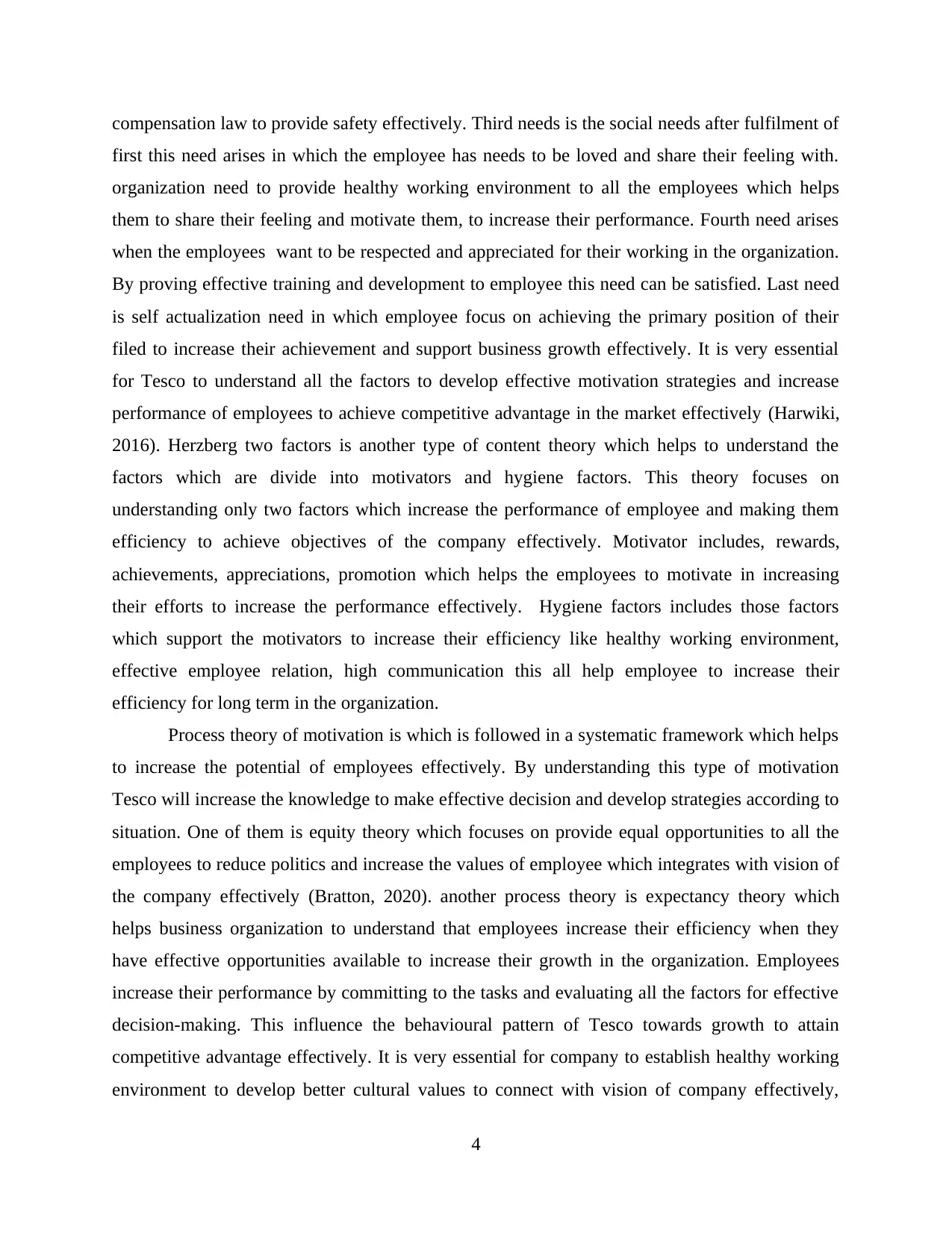
compensation law to provide safety effectively. Third needs is the social needs after fulfilment of
first this need arises in which the employee has needs to be loved and share their feeling with.
organization need to provide healthy working environment to all the employees which helps
them to share their feeling and motivate them, to increase their performance. Fourth need arises
when the employees want to be respected and appreciated for their working in the organization.
By proving effective training and development to employee this need can be satisfied. Last need
is self actualization need in which employee focus on achieving the primary position of their
filed to increase their achievement and support business growth effectively. It is very essential
for Tesco to understand all the factors to develop effective motivation strategies and increase
performance of employees to achieve competitive advantage in the market effectively (Harwiki,
2016). Herzberg two factors is another type of content theory which helps to understand the
factors which are divide into motivators and hygiene factors. This theory focuses on
understanding only two factors which increase the performance of employee and making them
efficiency to achieve objectives of the company effectively. Motivator includes, rewards,
achievements, appreciations, promotion which helps the employees to motivate in increasing
their efforts to increase the performance effectively. Hygiene factors includes those factors
which support the motivators to increase their efficiency like healthy working environment,
effective employee relation, high communication this all help employee to increase their
efficiency for long term in the organization.
Process theory of motivation is which is followed in a systematic framework which helps
to increase the potential of employees effectively. By understanding this type of motivation
Tesco will increase the knowledge to make effective decision and develop strategies according to
situation. One of them is equity theory which focuses on provide equal opportunities to all the
employees to reduce politics and increase the values of employee which integrates with vision of
the company effectively (Bratton, 2020). another process theory is expectancy theory which
helps business organization to understand that employees increase their efficiency when they
have effective opportunities available to increase their growth in the organization. Employees
increase their performance by committing to the tasks and evaluating all the factors for effective
decision-making. This influence the behavioural pattern of Tesco towards growth to attain
competitive advantage effectively. It is very essential for company to establish healthy working
environment to develop better cultural values to connect with vision of company effectively,
4
first this need arises in which the employee has needs to be loved and share their feeling with.
organization need to provide healthy working environment to all the employees which helps
them to share their feeling and motivate them, to increase their performance. Fourth need arises
when the employees want to be respected and appreciated for their working in the organization.
By proving effective training and development to employee this need can be satisfied. Last need
is self actualization need in which employee focus on achieving the primary position of their
filed to increase their achievement and support business growth effectively. It is very essential
for Tesco to understand all the factors to develop effective motivation strategies and increase
performance of employees to achieve competitive advantage in the market effectively (Harwiki,
2016). Herzberg two factors is another type of content theory which helps to understand the
factors which are divide into motivators and hygiene factors. This theory focuses on
understanding only two factors which increase the performance of employee and making them
efficiency to achieve objectives of the company effectively. Motivator includes, rewards,
achievements, appreciations, promotion which helps the employees to motivate in increasing
their efforts to increase the performance effectively. Hygiene factors includes those factors
which support the motivators to increase their efficiency like healthy working environment,
effective employee relation, high communication this all help employee to increase their
efficiency for long term in the organization.
Process theory of motivation is which is followed in a systematic framework which helps
to increase the potential of employees effectively. By understanding this type of motivation
Tesco will increase the knowledge to make effective decision and develop strategies according to
situation. One of them is equity theory which focuses on provide equal opportunities to all the
employees to reduce politics and increase the values of employee which integrates with vision of
the company effectively (Bratton, 2020). another process theory is expectancy theory which
helps business organization to understand that employees increase their efficiency when they
have effective opportunities available to increase their growth in the organization. Employees
increase their performance by committing to the tasks and evaluating all the factors for effective
decision-making. This influence the behavioural pattern of Tesco towards growth to attain
competitive advantage effectively. It is very essential for company to establish healthy working
environment to develop better cultural values to connect with vision of company effectively,
4
⊘ This is a preview!⊘
Do you want full access?
Subscribe today to unlock all pages.

Trusted by 1+ million students worldwide
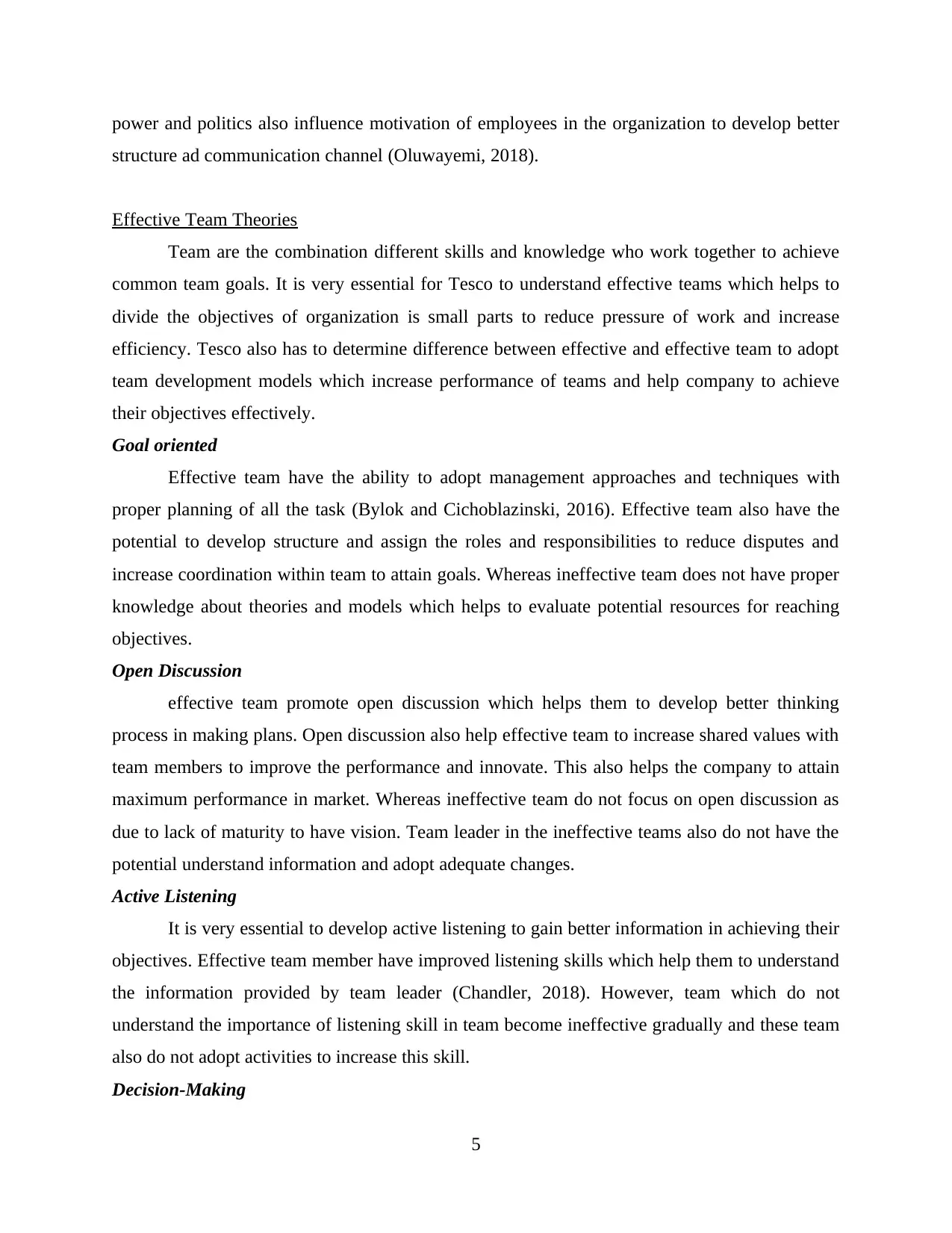
power and politics also influence motivation of employees in the organization to develop better
structure ad communication channel (Oluwayemi, 2018).
Effective Team Theories
Team are the combination different skills and knowledge who work together to achieve
common team goals. It is very essential for Tesco to understand effective teams which helps to
divide the objectives of organization is small parts to reduce pressure of work and increase
efficiency. Tesco also has to determine difference between effective and effective team to adopt
team development models which increase performance of teams and help company to achieve
their objectives effectively.
Goal oriented
Effective team have the ability to adopt management approaches and techniques with
proper planning of all the task (Bylok and Cichoblazinski, 2016). Effective team also have the
potential to develop structure and assign the roles and responsibilities to reduce disputes and
increase coordination within team to attain goals. Whereas ineffective team does not have proper
knowledge about theories and models which helps to evaluate potential resources for reaching
objectives.
Open Discussion
effective team promote open discussion which helps them to develop better thinking
process in making plans. Open discussion also help effective team to increase shared values with
team members to improve the performance and innovate. This also helps the company to attain
maximum performance in market. Whereas ineffective team do not focus on open discussion as
due to lack of maturity to have vision. Team leader in the ineffective teams also do not have the
potential understand information and adopt adequate changes.
Active Listening
It is very essential to develop active listening to gain better information in achieving their
objectives. Effective team member have improved listening skills which help them to understand
the information provided by team leader (Chandler, 2018). However, team which do not
understand the importance of listening skill in team become ineffective gradually and these team
also do not adopt activities to increase this skill.
Decision-Making
5
structure ad communication channel (Oluwayemi, 2018).
Effective Team Theories
Team are the combination different skills and knowledge who work together to achieve
common team goals. It is very essential for Tesco to understand effective teams which helps to
divide the objectives of organization is small parts to reduce pressure of work and increase
efficiency. Tesco also has to determine difference between effective and effective team to adopt
team development models which increase performance of teams and help company to achieve
their objectives effectively.
Goal oriented
Effective team have the ability to adopt management approaches and techniques with
proper planning of all the task (Bylok and Cichoblazinski, 2016). Effective team also have the
potential to develop structure and assign the roles and responsibilities to reduce disputes and
increase coordination within team to attain goals. Whereas ineffective team does not have proper
knowledge about theories and models which helps to evaluate potential resources for reaching
objectives.
Open Discussion
effective team promote open discussion which helps them to develop better thinking
process in making plans. Open discussion also help effective team to increase shared values with
team members to improve the performance and innovate. This also helps the company to attain
maximum performance in market. Whereas ineffective team do not focus on open discussion as
due to lack of maturity to have vision. Team leader in the ineffective teams also do not have the
potential understand information and adopt adequate changes.
Active Listening
It is very essential to develop active listening to gain better information in achieving their
objectives. Effective team member have improved listening skills which help them to understand
the information provided by team leader (Chandler, 2018). However, team which do not
understand the importance of listening skill in team become ineffective gradually and these team
also do not adopt activities to increase this skill.
Decision-Making
5
Paraphrase This Document
Need a fresh take? Get an instant paraphrase of this document with our AI Paraphraser
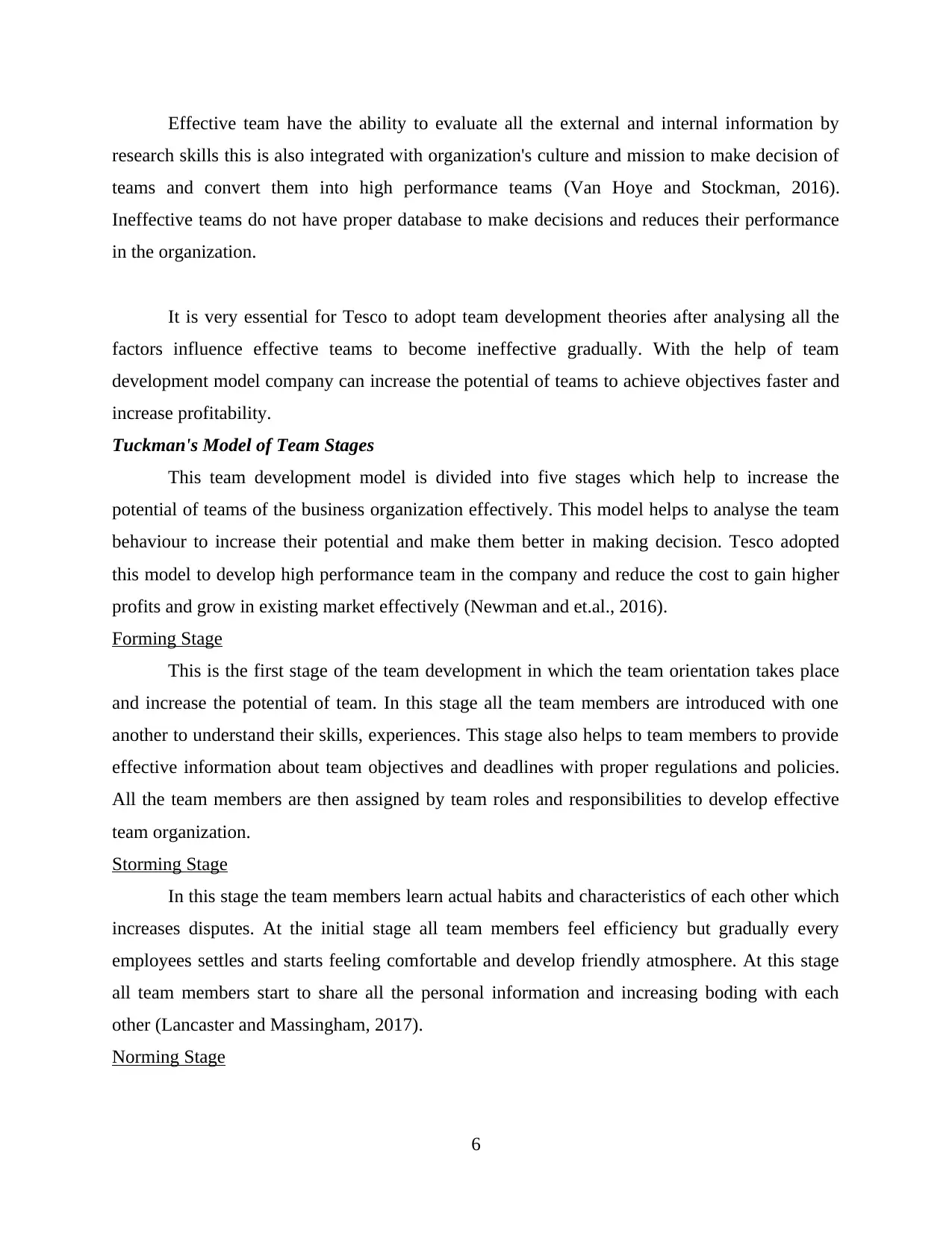
Effective team have the ability to evaluate all the external and internal information by
research skills this is also integrated with organization's culture and mission to make decision of
teams and convert them into high performance teams (Van Hoye and Stockman, 2016).
Ineffective teams do not have proper database to make decisions and reduces their performance
in the organization.
It is very essential for Tesco to adopt team development theories after analysing all the
factors influence effective teams to become ineffective gradually. With the help of team
development model company can increase the potential of teams to achieve objectives faster and
increase profitability.
Tuckman's Model of Team Stages
This team development model is divided into five stages which help to increase the
potential of teams of the business organization effectively. This model helps to analyse the team
behaviour to increase their potential and make them better in making decision. Tesco adopted
this model to develop high performance team in the company and reduce the cost to gain higher
profits and grow in existing market effectively (Newman and et.al., 2016).
Forming Stage
This is the first stage of the team development in which the team orientation takes place
and increase the potential of team. In this stage all the team members are introduced with one
another to understand their skills, experiences. This stage also helps to team members to provide
effective information about team objectives and deadlines with proper regulations and policies.
All the team members are then assigned by team roles and responsibilities to develop effective
team organization.
Storming Stage
In this stage the team members learn actual habits and characteristics of each other which
increases disputes. At the initial stage all team members feel efficiency but gradually every
employees settles and starts feeling comfortable and develop friendly atmosphere. At this stage
all team members start to share all the personal information and increasing boding with each
other (Lancaster and Massingham, 2017).
Norming Stage
6
research skills this is also integrated with organization's culture and mission to make decision of
teams and convert them into high performance teams (Van Hoye and Stockman, 2016).
Ineffective teams do not have proper database to make decisions and reduces their performance
in the organization.
It is very essential for Tesco to adopt team development theories after analysing all the
factors influence effective teams to become ineffective gradually. With the help of team
development model company can increase the potential of teams to achieve objectives faster and
increase profitability.
Tuckman's Model of Team Stages
This team development model is divided into five stages which help to increase the
potential of teams of the business organization effectively. This model helps to analyse the team
behaviour to increase their potential and make them better in making decision. Tesco adopted
this model to develop high performance team in the company and reduce the cost to gain higher
profits and grow in existing market effectively (Newman and et.al., 2016).
Forming Stage
This is the first stage of the team development in which the team orientation takes place
and increase the potential of team. In this stage all the team members are introduced with one
another to understand their skills, experiences. This stage also helps to team members to provide
effective information about team objectives and deadlines with proper regulations and policies.
All the team members are then assigned by team roles and responsibilities to develop effective
team organization.
Storming Stage
In this stage the team members learn actual habits and characteristics of each other which
increases disputes. At the initial stage all team members feel efficiency but gradually every
employees settles and starts feeling comfortable and develop friendly atmosphere. At this stage
all team members start to share all the personal information and increasing boding with each
other (Lancaster and Massingham, 2017).
Norming Stage
6
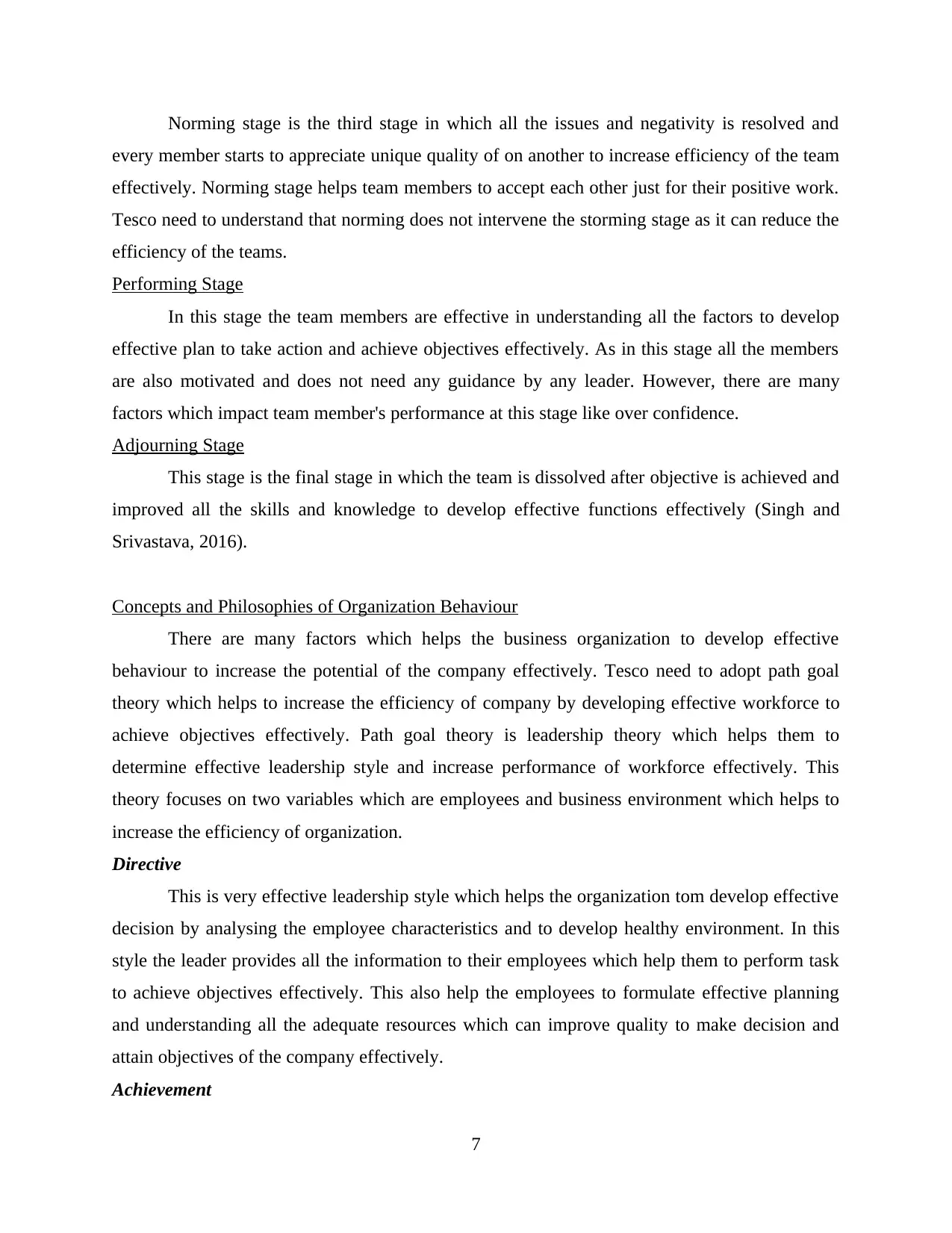
Norming stage is the third stage in which all the issues and negativity is resolved and
every member starts to appreciate unique quality of on another to increase efficiency of the team
effectively. Norming stage helps team members to accept each other just for their positive work.
Tesco need to understand that norming does not intervene the storming stage as it can reduce the
efficiency of the teams.
Performing Stage
In this stage the team members are effective in understanding all the factors to develop
effective plan to take action and achieve objectives effectively. As in this stage all the members
are also motivated and does not need any guidance by any leader. However, there are many
factors which impact team member's performance at this stage like over confidence.
Adjourning Stage
This stage is the final stage in which the team is dissolved after objective is achieved and
improved all the skills and knowledge to develop effective functions effectively (Singh and
Srivastava, 2016).
Concepts and Philosophies of Organization Behaviour
There are many factors which helps the business organization to develop effective
behaviour to increase the potential of the company effectively. Tesco need to adopt path goal
theory which helps to increase the efficiency of company by developing effective workforce to
achieve objectives effectively. Path goal theory is leadership theory which helps them to
determine effective leadership style and increase performance of workforce effectively. This
theory focuses on two variables which are employees and business environment which helps to
increase the efficiency of organization.
Directive
This is very effective leadership style which helps the organization tom develop effective
decision by analysing the employee characteristics and to develop healthy environment. In this
style the leader provides all the information to their employees which help them to perform task
to achieve objectives effectively. This also help the employees to formulate effective planning
and understanding all the adequate resources which can improve quality to make decision and
attain objectives of the company effectively.
Achievement
7
every member starts to appreciate unique quality of on another to increase efficiency of the team
effectively. Norming stage helps team members to accept each other just for their positive work.
Tesco need to understand that norming does not intervene the storming stage as it can reduce the
efficiency of the teams.
Performing Stage
In this stage the team members are effective in understanding all the factors to develop
effective plan to take action and achieve objectives effectively. As in this stage all the members
are also motivated and does not need any guidance by any leader. However, there are many
factors which impact team member's performance at this stage like over confidence.
Adjourning Stage
This stage is the final stage in which the team is dissolved after objective is achieved and
improved all the skills and knowledge to develop effective functions effectively (Singh and
Srivastava, 2016).
Concepts and Philosophies of Organization Behaviour
There are many factors which helps the business organization to develop effective
behaviour to increase the potential of the company effectively. Tesco need to adopt path goal
theory which helps to increase the efficiency of company by developing effective workforce to
achieve objectives effectively. Path goal theory is leadership theory which helps them to
determine effective leadership style and increase performance of workforce effectively. This
theory focuses on two variables which are employees and business environment which helps to
increase the efficiency of organization.
Directive
This is very effective leadership style which helps the organization tom develop effective
decision by analysing the employee characteristics and to develop healthy environment. In this
style the leader provides all the information to their employees which help them to perform task
to achieve objectives effectively. This also help the employees to formulate effective planning
and understanding all the adequate resources which can improve quality to make decision and
attain objectives of the company effectively.
Achievement
7
⊘ This is a preview!⊘
Do you want full access?
Subscribe today to unlock all pages.

Trusted by 1+ million students worldwide
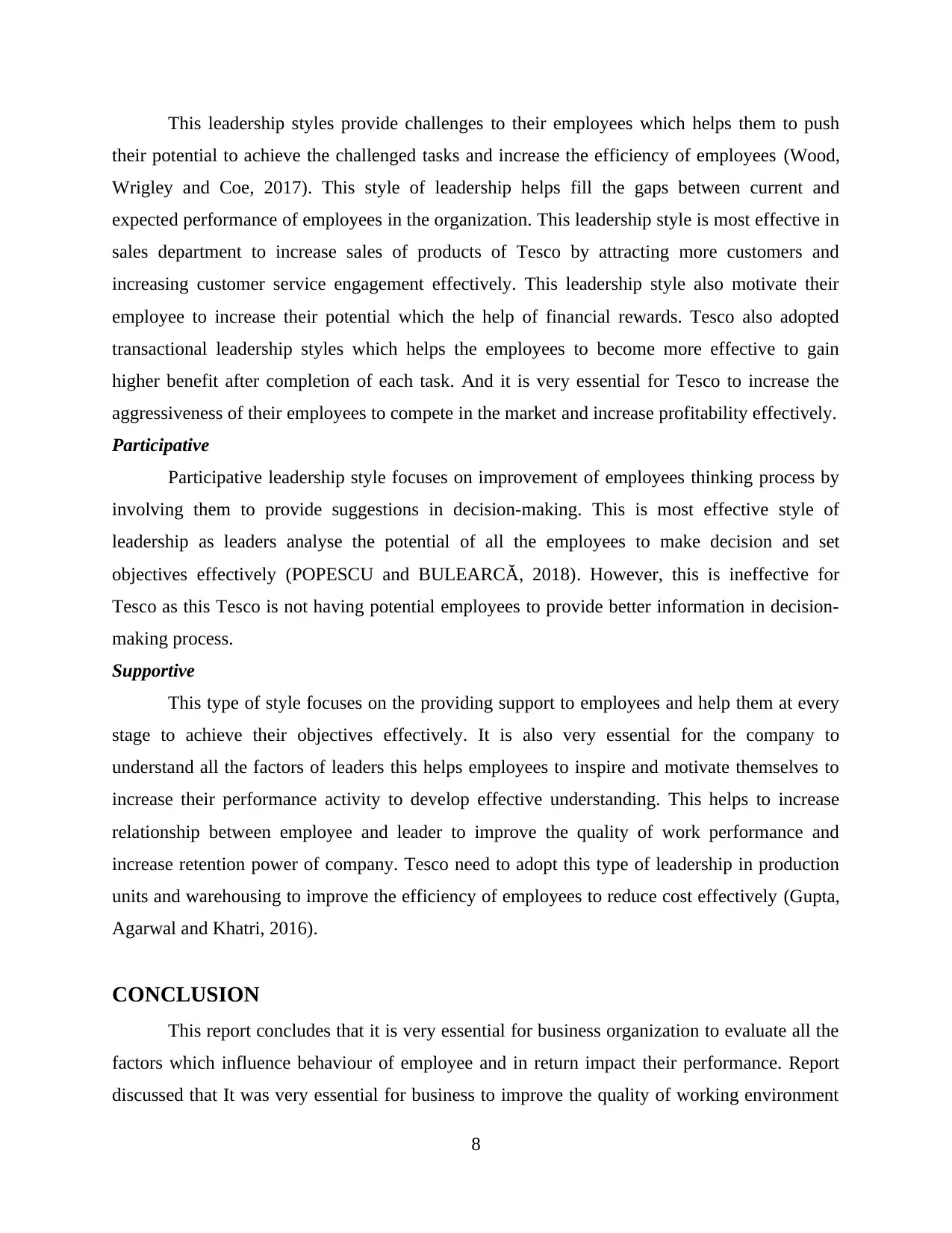
This leadership styles provide challenges to their employees which helps them to push
their potential to achieve the challenged tasks and increase the efficiency of employees (Wood,
Wrigley and Coe, 2017). This style of leadership helps fill the gaps between current and
expected performance of employees in the organization. This leadership style is most effective in
sales department to increase sales of products of Tesco by attracting more customers and
increasing customer service engagement effectively. This leadership style also motivate their
employee to increase their potential which the help of financial rewards. Tesco also adopted
transactional leadership styles which helps the employees to become more effective to gain
higher benefit after completion of each task. And it is very essential for Tesco to increase the
aggressiveness of their employees to compete in the market and increase profitability effectively.
Participative
Participative leadership style focuses on improvement of employees thinking process by
involving them to provide suggestions in decision-making. This is most effective style of
leadership as leaders analyse the potential of all the employees to make decision and set
objectives effectively (POPESCU and BULEARCĂ, 2018). However, this is ineffective for
Tesco as this Tesco is not having potential employees to provide better information in decision-
making process.
Supportive
This type of style focuses on the providing support to employees and help them at every
stage to achieve their objectives effectively. It is also very essential for the company to
understand all the factors of leaders this helps employees to inspire and motivate themselves to
increase their performance activity to develop effective understanding. This helps to increase
relationship between employee and leader to improve the quality of work performance and
increase retention power of company. Tesco need to adopt this type of leadership in production
units and warehousing to improve the efficiency of employees to reduce cost effectively (Gupta,
Agarwal and Khatri, 2016).
CONCLUSION
This report concludes that it is very essential for business organization to evaluate all the
factors which influence behaviour of employee and in return impact their performance. Report
discussed that It was very essential for business to improve the quality of working environment
8
their potential to achieve the challenged tasks and increase the efficiency of employees (Wood,
Wrigley and Coe, 2017). This style of leadership helps fill the gaps between current and
expected performance of employees in the organization. This leadership style is most effective in
sales department to increase sales of products of Tesco by attracting more customers and
increasing customer service engagement effectively. This leadership style also motivate their
employee to increase their potential which the help of financial rewards. Tesco also adopted
transactional leadership styles which helps the employees to become more effective to gain
higher benefit after completion of each task. And it is very essential for Tesco to increase the
aggressiveness of their employees to compete in the market and increase profitability effectively.
Participative
Participative leadership style focuses on improvement of employees thinking process by
involving them to provide suggestions in decision-making. This is most effective style of
leadership as leaders analyse the potential of all the employees to make decision and set
objectives effectively (POPESCU and BULEARCĂ, 2018). However, this is ineffective for
Tesco as this Tesco is not having potential employees to provide better information in decision-
making process.
Supportive
This type of style focuses on the providing support to employees and help them at every
stage to achieve their objectives effectively. It is also very essential for the company to
understand all the factors of leaders this helps employees to inspire and motivate themselves to
increase their performance activity to develop effective understanding. This helps to increase
relationship between employee and leader to improve the quality of work performance and
increase retention power of company. Tesco need to adopt this type of leadership in production
units and warehousing to improve the efficiency of employees to reduce cost effectively (Gupta,
Agarwal and Khatri, 2016).
CONCLUSION
This report concludes that it is very essential for business organization to evaluate all the
factors which influence behaviour of employee and in return impact their performance. Report
discussed that It was very essential for business to improve the quality of working environment
8
Paraphrase This Document
Need a fresh take? Get an instant paraphrase of this document with our AI Paraphraser
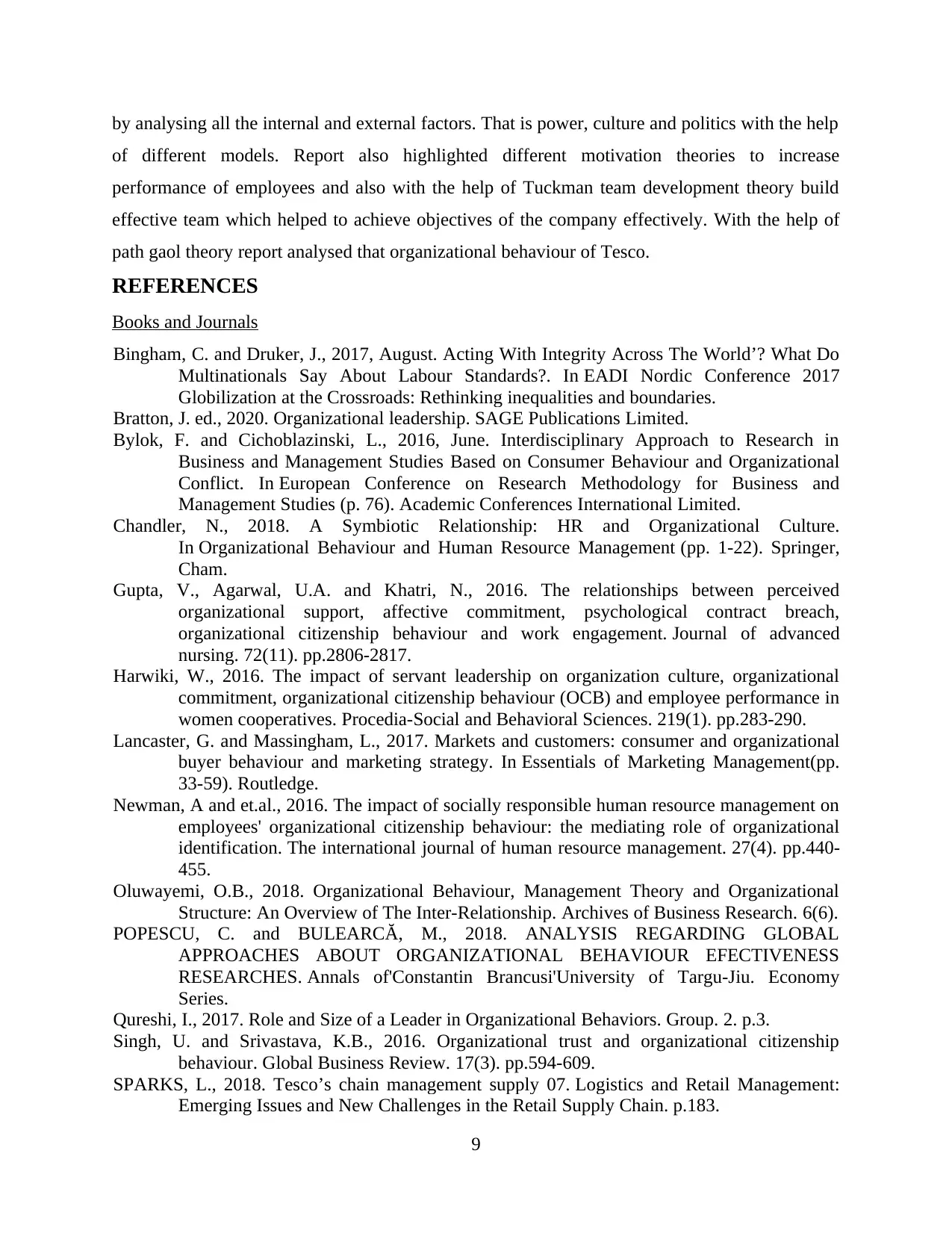
by analysing all the internal and external factors. That is power, culture and politics with the help
of different models. Report also highlighted different motivation theories to increase
performance of employees and also with the help of Tuckman team development theory build
effective team which helped to achieve objectives of the company effectively. With the help of
path gaol theory report analysed that organizational behaviour of Tesco.
REFERENCES
Books and Journals
Bingham, C. and Druker, J., 2017, August. Acting With Integrity Across The World’? What Do
Multinationals Say About Labour Standards?. In EADI Nordic Conference 2017
Globilization at the Crossroads: Rethinking inequalities and boundaries.
Bratton, J. ed., 2020. Organizational leadership. SAGE Publications Limited.
Bylok, F. and Cichoblazinski, L., 2016, June. Interdisciplinary Approach to Research in
Business and Management Studies Based on Consumer Behaviour and Organizational
Conflict. In European Conference on Research Methodology for Business and
Management Studies (p. 76). Academic Conferences International Limited.
Chandler, N., 2018. A Symbiotic Relationship: HR and Organizational Culture.
In Organizational Behaviour and Human Resource Management (pp. 1-22). Springer,
Cham.
Gupta, V., Agarwal, U.A. and Khatri, N., 2016. The relationships between perceived
organizational support, affective commitment, psychological contract breach,
organizational citizenship behaviour and work engagement. Journal of advanced
nursing. 72(11). pp.2806-2817.
Harwiki, W., 2016. The impact of servant leadership on organization culture, organizational
commitment, organizational citizenship behaviour (OCB) and employee performance in
women cooperatives. Procedia-Social and Behavioral Sciences. 219(1). pp.283-290.
Lancaster, G. and Massingham, L., 2017. Markets and customers: consumer and organizational
buyer behaviour and marketing strategy. In Essentials of Marketing Management(pp.
33-59). Routledge.
Newman, A and et.al., 2016. The impact of socially responsible human resource management on
employees' organizational citizenship behaviour: the mediating role of organizational
identification. The international journal of human resource management. 27(4). pp.440-
455.
Oluwayemi, O.B., 2018. Organizational Behaviour, Management Theory and Organizational
Structure: An Overview of The Inter-Relationship. Archives of Business Research. 6(6).
POPESCU, C. and BULEARCĂ, M., 2018. ANALYSIS REGARDING GLOBAL
APPROACHES ABOUT ORGANIZATIONAL BEHAVIOUR EFECTIVENESS
RESEARCHES. Annals of'Constantin Brancusi'University of Targu-Jiu. Economy
Series.
Qureshi, I., 2017. Role and Size of a Leader in Organizational Behaviors. Group. 2. p.3.
Singh, U. and Srivastava, K.B., 2016. Organizational trust and organizational citizenship
behaviour. Global Business Review. 17(3). pp.594-609.
SPARKS, L., 2018. Tesco’s chain management supply 07. Logistics and Retail Management:
Emerging Issues and New Challenges in the Retail Supply Chain. p.183.
9
of different models. Report also highlighted different motivation theories to increase
performance of employees and also with the help of Tuckman team development theory build
effective team which helped to achieve objectives of the company effectively. With the help of
path gaol theory report analysed that organizational behaviour of Tesco.
REFERENCES
Books and Journals
Bingham, C. and Druker, J., 2017, August. Acting With Integrity Across The World’? What Do
Multinationals Say About Labour Standards?. In EADI Nordic Conference 2017
Globilization at the Crossroads: Rethinking inequalities and boundaries.
Bratton, J. ed., 2020. Organizational leadership. SAGE Publications Limited.
Bylok, F. and Cichoblazinski, L., 2016, June. Interdisciplinary Approach to Research in
Business and Management Studies Based on Consumer Behaviour and Organizational
Conflict. In European Conference on Research Methodology for Business and
Management Studies (p. 76). Academic Conferences International Limited.
Chandler, N., 2018. A Symbiotic Relationship: HR and Organizational Culture.
In Organizational Behaviour and Human Resource Management (pp. 1-22). Springer,
Cham.
Gupta, V., Agarwal, U.A. and Khatri, N., 2016. The relationships between perceived
organizational support, affective commitment, psychological contract breach,
organizational citizenship behaviour and work engagement. Journal of advanced
nursing. 72(11). pp.2806-2817.
Harwiki, W., 2016. The impact of servant leadership on organization culture, organizational
commitment, organizational citizenship behaviour (OCB) and employee performance in
women cooperatives. Procedia-Social and Behavioral Sciences. 219(1). pp.283-290.
Lancaster, G. and Massingham, L., 2017. Markets and customers: consumer and organizational
buyer behaviour and marketing strategy. In Essentials of Marketing Management(pp.
33-59). Routledge.
Newman, A and et.al., 2016. The impact of socially responsible human resource management on
employees' organizational citizenship behaviour: the mediating role of organizational
identification. The international journal of human resource management. 27(4). pp.440-
455.
Oluwayemi, O.B., 2018. Organizational Behaviour, Management Theory and Organizational
Structure: An Overview of The Inter-Relationship. Archives of Business Research. 6(6).
POPESCU, C. and BULEARCĂ, M., 2018. ANALYSIS REGARDING GLOBAL
APPROACHES ABOUT ORGANIZATIONAL BEHAVIOUR EFECTIVENESS
RESEARCHES. Annals of'Constantin Brancusi'University of Targu-Jiu. Economy
Series.
Qureshi, I., 2017. Role and Size of a Leader in Organizational Behaviors. Group. 2. p.3.
Singh, U. and Srivastava, K.B., 2016. Organizational trust and organizational citizenship
behaviour. Global Business Review. 17(3). pp.594-609.
SPARKS, L., 2018. Tesco’s chain management supply 07. Logistics and Retail Management:
Emerging Issues and New Challenges in the Retail Supply Chain. p.183.
9
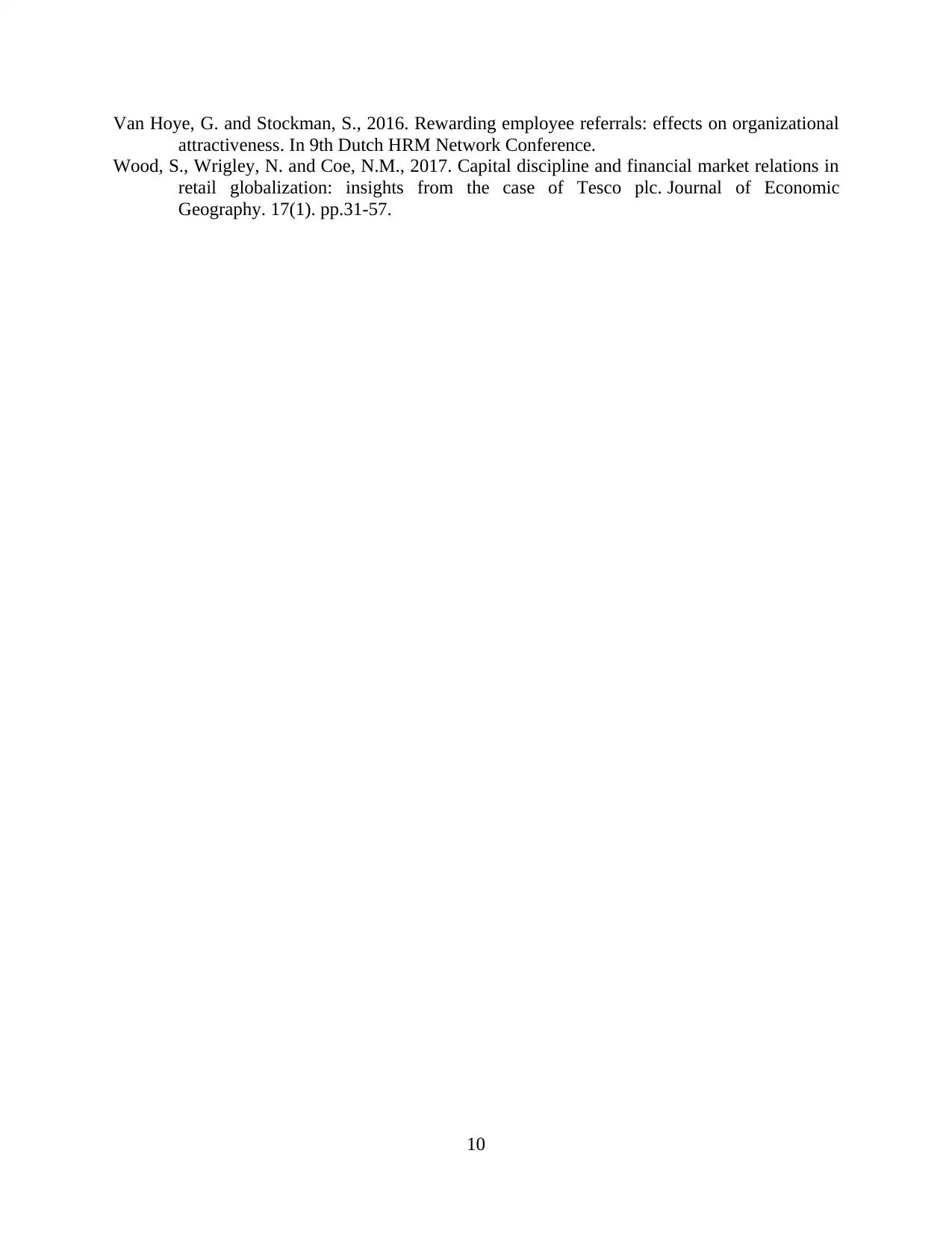
Van Hoye, G. and Stockman, S., 2016. Rewarding employee referrals: effects on organizational
attractiveness. In 9th Dutch HRM Network Conference.
Wood, S., Wrigley, N. and Coe, N.M., 2017. Capital discipline and financial market relations in
retail globalization: insights from the case of Tesco plc. Journal of Economic
Geography. 17(1). pp.31-57.
10
attractiveness. In 9th Dutch HRM Network Conference.
Wood, S., Wrigley, N. and Coe, N.M., 2017. Capital discipline and financial market relations in
retail globalization: insights from the case of Tesco plc. Journal of Economic
Geography. 17(1). pp.31-57.
10
⊘ This is a preview!⊘
Do you want full access?
Subscribe today to unlock all pages.

Trusted by 1+ million students worldwide
1 out of 12
Related Documents
Your All-in-One AI-Powered Toolkit for Academic Success.
+13062052269
info@desklib.com
Available 24*7 on WhatsApp / Email
![[object Object]](/_next/static/media/star-bottom.7253800d.svg)
Unlock your academic potential
Copyright © 2020–2025 A2Z Services. All Rights Reserved. Developed and managed by ZUCOL.



